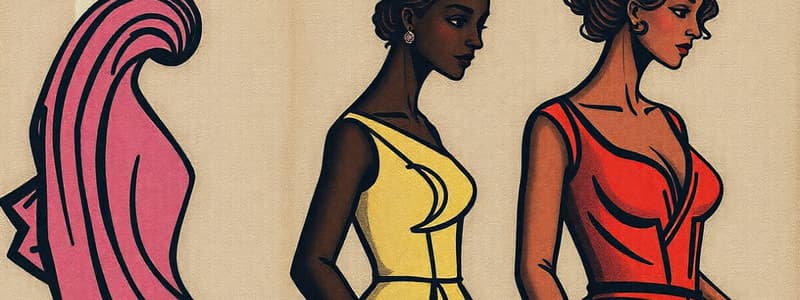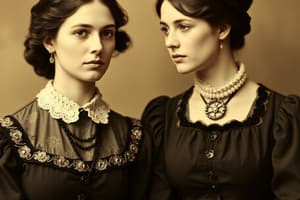Podcast
Questions and Answers
Who is the author of the work from which this excerpt is taken?
Who is the author of the work from which this excerpt is taken?
- American Historical Association
- Fowler
- Oxford University Press
- Joan W. Scott (correct)
In which publication did this excerpt originally appear?
In which publication did this excerpt originally appear?
- Oxford English Dictionary
- JSTOR
- Fowler's Dictionary of Modern English Usage
- The American Historical Review (correct)
What year was Volume 91, No. 5 of The American Historical Review, which contains this excerpt, published?
What year was Volume 91, No. 5 of The American Historical Review, which contains this excerpt, published?
- 1985
- 1986 (correct)
- 1990
- 1991
According to the provided excerpt, Fowler's Dictionary of Modern English Usage was published in which year?
According to the provided excerpt, Fowler's Dictionary of Modern English Usage was published in which year?
Fowler's Dictionary primarily defines 'gender' within which domain?
Fowler's Dictionary primarily defines 'gender' within which domain?
In Fowler's view as presented, using 'gender' to refer to male or female sex is considered to be what, depending on context?
In Fowler's view as presented, using 'gender' to refer to male or female sex is considered to be what, depending on context?
The title of the article, 'Gender: A Useful Category of Historical Analysis', suggests that the author will likely argue for the value of gender in what field?
The title of the article, 'Gender: A Useful Category of Historical Analysis', suggests that the author will likely argue for the value of gender in what field?
According to the excerpt, JSTOR's role is primarily to do what for scholarly content?
According to the excerpt, JSTOR's role is primarily to do what for scholarly content?
What is the primary critique of theories that explain gender solely through physical differences?
What is the primary critique of theories that explain gender solely through physical differences?
What self-imposed constraint has potentially hindered the development of new analytical perspectives within Marxist feminism?
What self-imposed constraint has potentially hindered the development of new analytical perspectives within Marxist feminism?
In Marxist feminist analysis, as described in the text, where are the origins and changes in gender systems primarily located?
In Marxist feminist analysis, as described in the text, where are the origins and changes in gender systems primarily located?
What is the ultimate relationship between patriarchy and capitalism in Heidi Hartmann's analysis?
What is the ultimate relationship between patriarchy and capitalism in Heidi Hartmann's analysis?
What is a primary weakness of some historical theories?
What is a primary weakness of some historical theories?
What are the two main categories of approaches to 'gender' used by historians, as outlined in the text?
What are the two main categories of approaches to 'gender' used by historians, as outlined in the text?
What do Engels's and Hartmann's explorations of gender systems, as mentioned in the text, ultimately suggest about the driving force behind changes in family, household, and sexuality?
What do Engels's and Hartmann's explorations of gender systems, as mentioned in the text, ultimately suggest about the driving force behind changes in family, household, and sexuality?
Which characteristic defines the 'descriptive' approach to 'gender' in historical analysis, according to the text?
Which characteristic defines the 'descriptive' approach to 'gender' in historical analysis, according to the text?
What is the primary goal of the 'causal' approach to 'gender' in historical analysis, as described in the text?
What is the primary goal of the 'causal' approach to 'gender' in historical analysis, as described in the text?
In its simplest recent usage, as described in the text, what is 'gender' often used as a synonym for?
In its simplest recent usage, as described in the text, what is 'gender' often used as a synonym for?
Why might some scholars substitute 'gender' for 'women' in the titles of their works?
Why might some scholars substitute 'gender' for 'women' in the titles of their works?
How does the term 'gender,' when used as a substitute for 'women,' differ politically from 'women's history,' according to the text?
How does the term 'gender,' when used as a substitute for 'women,' differ politically from 'women's history,' according to the text?
What implication does the usage of 'gender' as a substitute for 'women' carry regarding the relationship between men and women, as described in the text?
What implication does the usage of 'gender' as a substitute for 'women' carry regarding the relationship between men and women, as described in the text?
The text argues for understanding social phenomena by focusing on:
The text argues for understanding social phenomena by focusing on:
Investigating 'how things happened' is crucial for:
Investigating 'how things happened' is crucial for:
Michelle Rosaldo's perspective, as presented in the text, suggests that a woman's position in society is primarily determined by:
Michelle Rosaldo's perspective, as presented in the text, suggests that a woman's position in society is primarily determined by:
To comprehend how gender operates and social change occurs, it is essential to consider:
To comprehend how gender operates and social change occurs, it is essential to consider:
The text contrasts the notion of unified social power with Foucault's idea of power as:
The text contrasts the notion of unified social power with Foucault's idea of power as:
Human agency, as described in the text, involves the attempt to construct identity and society within:
Human agency, as described in the text, involves the attempt to construct identity and society within:
According to the text's definition, gender is fundamentally:
According to the text's definition, gender is fundamentally:
The relationship between changes in social relationships and representations of power is described as:
The relationship between changes in social relationships and representations of power is described as:
According to the provided text, what is a crucial characteristic of the four elements constituting the definition of gender?
According to the provided text, what is a crucial characteristic of the four elements constituting the definition of gender?
The author suggests that a key area for historical research regarding gender is understanding:
The author suggests that a key area for historical research regarding gender is understanding:
What is the primary purpose of the author's sketch of the process of constructing gender relationships?
What is the primary purpose of the author's sketch of the process of constructing gender relationships?
Gender functions as 'a primary way of signifying relationships of power' or, more precisely, as:
Gender functions as 'a primary way of signifying relationships of power' or, more precisely, as:
While gender is considered a primary field for articulating power, the text indicates that it is:
While gender is considered a primary field for articulating power, the text indicates that it is:
Concepts of power, as discussed in relation to gender, are described as:
Concepts of power, as discussed in relation to gender, are described as:
The text mentions studies by Sinha and Ratte focusing on gender identity construction in the context of:
The text mentions studies by Sinha and Ratte focusing on gender identity construction in the context of:
The author critiques the typical thinking about gender in social and institutional relationships as often being:
The author critiques the typical thinking about gender in social and institutional relationships as often being:
Which historical event is presented as an example where emergent rulers linked masculinity with dominance and femininity with weakness?
Which historical event is presented as an example where emergent rulers linked masculinity with dominance and femininity with weakness?
According to the content, what is a common characteristic observed in authoritarian regimes concerning women?
According to the content, what is a common characteristic observed in authoritarian regimes concerning women?
What is the primary interpretation given in the text for the timing of actions taken against women by emergent authoritarian rulers?
What is the primary interpretation given in the text for the timing of actions taken against women by emergent authoritarian rulers?
In the context of emergent rulers and control over women, what is presented as the underlying purpose of policies targeting women?
In the context of emergent rulers and control over women, what is presented as the underlying purpose of policies targeting women?
How does the content describe the conceptualization of 'sexual difference' in the examples provided of authoritarian regimes?
How does the content describe the conceptualization of 'sexual difference' in the examples provided of authoritarian regimes?
What does the text imply about the relationship between legal changes affecting marital relationships and broader societal views?
What does the text imply about the relationship between legal changes affecting marital relationships and broader societal views?
According to the content, which contemporary group shares a similarity with historical authoritarian regimes in their approach to family and gender roles?
According to the content, which contemporary group shares a similarity with historical authoritarian regimes in their approach to family and gender roles?
What overarching theme connects the examples of historical and contemporary actions concerning women discussed in the content?
What overarching theme connects the examples of historical and contemporary actions concerning women discussed in the content?
Flashcards
Grammatical Gender
Grammatical Gender
The grammatical category that differentiates nouns based on sex (masculine, feminine, or neuter). It's distinct from 'sex', which refers to biological differences.
Misuse of 'Gender'
Misuse of 'Gender'
The misuse of 'gender' to refer to biological sex, typically male or female, is considered a grammatical error or humorous mistake.
Gender as a Historical Lens
Gender as a Historical Lens
Gender is a useful category to examine the historical construction of masculinity and femininity. It helps us understand how social arrangements shape roles, behaviors, and identities.
Gender is Socially Constructed
Gender is Socially Constructed
Signup and view all the flashcards
Importance of Gender Studies
Importance of Gender Studies
Signup and view all the flashcards
Gender Beyond Biology
Gender Beyond Biology
Signup and view all the flashcards
Gender is Fluid and Evolving
Gender is Fluid and Evolving
Signup and view all the flashcards
Gender and History
Gender and History
Signup and view all the flashcards
Reductive Theories
Reductive Theories
Signup and view all the flashcards
Gender History
Gender History
Signup and view all the flashcards
Gender as a Neutral Term
Gender as a Neutral Term
Signup and view all the flashcards
Women's History as Part of Men's History
Women's History as Part of Men's History
Signup and view all the flashcards
Academic Legitimacy in Feminist Scholarship
Academic Legitimacy in Feminist Scholarship
Signup and view all the flashcards
Causal History
Causal History
Signup and view all the flashcards
Descriptive History
Descriptive History
Signup and view all the flashcards
Social Causation
Social Causation
Signup and view all the flashcards
Biological Determinism
Biological Determinism
Signup and view all the flashcards
Ahistoricity of Gender
Ahistoricity of Gender
Signup and view all the flashcards
Dual-Systems Theory
Dual-Systems Theory
Signup and view all the flashcards
Materialist Explanation of Gender
Materialist Explanation of Gender
Signup and view all the flashcards
Origins of the Family
Origins of the Family
Signup and view all the flashcards
Gender as a field of power
Gender as a field of power
Signup and view all the flashcards
Gender's influence on social dynamics
Gender's influence on social dynamics
Signup and view all the flashcards
Intertwined elements of gender
Intertwined elements of gender
Signup and view all the flashcards
Gender's role in power in Western culture
Gender's role in power in Western culture
Signup and view all the flashcards
Gender's impact on social relationships
Gender's impact on social relationships
Signup and view all the flashcards
Historical evolution of gender
Historical evolution of gender
Signup and view all the flashcards
Construction of gender roles
Construction of gender roles
Signup and view all the flashcards
Gender as a lens for understanding social groups
Gender as a lens for understanding social groups
Signup and view all the flashcards
What is gender?
What is gender?
Signup and view all the flashcards
Why study interconnected processes?
Why study interconnected processes?
Signup and view all the flashcards
How do we understand social actions?
How do we understand social actions?
Signup and view all the flashcards
What is power like?
What is power like?
Signup and view all the flashcards
How do people shape their lives?
How do people shape their lives?
Signup and view all the flashcards
What are the key parts of gender?
What are the key parts of gender?
Signup and view all the flashcards
How do social changes affect power?
How do social changes affect power?
Signup and view all the flashcards
What makes a good historical study?
What makes a good historical study?
Signup and view all the flashcards
Authoritarian Regimes and Control of Women
Authoritarian Regimes and Control of Women
Signup and view all the flashcards
Power and Gender
Power and Gender
Signup and view all the flashcards
Study Notes
Gender: A Useful Category of Historical Analysis
- Gender is a grammatical term only, referring to the male or female sex. Historically, the meaning of words, like the concept of gender, evolves.
- Feminist historians use "gender" to describe the social organization of the relationship between sexes, rejecting biological determinism.
- The term "gender" is relational, meaning men and women are defined in terms of each other, and cannot be studied in isolation.
- "Gender" has been used to describe the historical analysis of women and men, focusing on the significance of sexes and gender roles in different societies and periods.
- Historians consider gender as a category of analysis in feminist scholarship, broadening the study of women's history to consider relational aspects.
- Gender is a social construction, not a biological one. This means that societies create ideas about what it means to be a man or woman.
- Understanding the significance of gender requires an examination of its historical context, specifically within different societies and time periods.
- Historical analyses of gender must move beyond a fixed, unchanging binary opposition of male and female, recognizing the complexity and variability of gender across time.
- The meaning of gender is contextual and contingent. It varies across cultures and time periods.
Studying That Suits You
Use AI to generate personalized quizzes and flashcards to suit your learning preferences.




